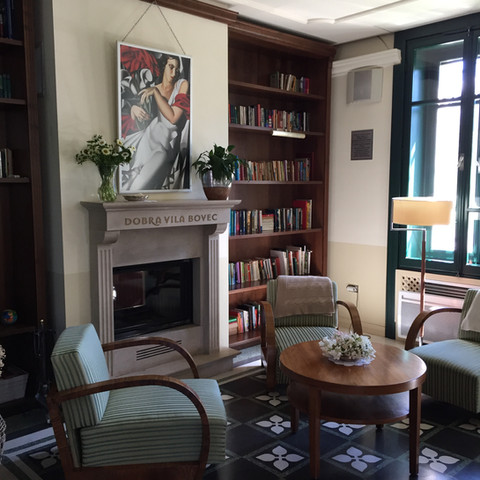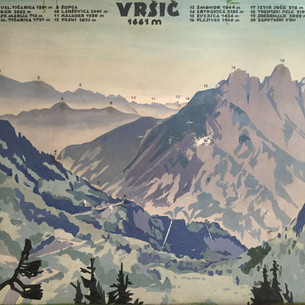Once upon a time, there was a magical little town in the Julian Alps with a Medieval square around which sat colourful houses and a hotel that was also a gingerbread bakery. To enter the hotel's car park, you needed to find the gnarled tree with a hole in its trunk, reach inside, pull out a key, and open the padlocked chain. The time was five years ago, and the town was Radovljica in Slovenia, just a 10-minute drive from the equally magical Lake Bled.
Radovljica was one of the stops on a road trip my parents and I made in the summer of 2016, starting in Munich, heading to Kaprun in Austria, then over the Vrišič Pass (where I met a lamb who stopped me eating meat - more on that later) to Radovljica and Ljubljana in Slovenia, Pula in Croatia, Trieste in Italy, and ending in Venice for me while my parents drove back up to Munich. All in all, it was one of the best summer hols we've ever had which is unusual since, being frugal Yorkshire folk, summer had always been considered the best time to stay at home. Holidays were for other times of the year when places were less crowded and prices much cheaper, and when the climate in Tashkent or Tallinn or Teotihuacán was more temperate. But in 2016, work contrived to keep me busy most of the year apart from a couple of weeks in August, so off we went.
We planned to stay around Lake Bled, but this being the middle of summer and most hotels being full and/or pricey my Dad, in the running to be the World's Top Internet Travel Researcher, discovered the nearby small town of Radovljica and the Pension Lectar (how many times we joked about whether Hannibal was in residence). The Lectar has been a family-run hotel for 180 years, housed in a 500-year old building on the traffic-free Linhart Square with an onsite bakery where gingerbread hearts (lect in Slovenian, hence the name) are made and decorated. You park your car just outside the square in a small chained-off area, look for that aforementioned tree, and fish around in the hole until you find the key. It has that sense of magical realism that makes Latin American literature so wonderful, transplanted straight into the heart of Central Europe.
But first, the drive. The moderately sized car we'd rented at Munich Airport turned out to have a flat tyre, so we were offered a behemoth Ford estate instead. I'd never driven anything so long, and practically had to send radio signals to my Mum in the back seat every time I wanted to tell her to look at the field of cows or the sign telling us we'd just entered Slovenia. Our journey was blessed with cerulean skies and meadows the colour of the Emerald City, and soon after crossing the border we stopped in Bovec for coffee. Surrounded by the Julian Alps and carpeted with wildflowers, we drove past a handsome building which was once the local telephone exchange but now houses the Dobra Vila hotel, and I did a quick turnaround (or not so quick since I was lugging around what felt like 10 metres of car). Sitting in the sun, sipping coffee, smelling the flowers, this went down as one of the loveliest pit stops of all time.
Refreshed and caffeinated, we got back in the behemoth and continued to the small, pretty town of Kobarid, previously known as Caporetto, the scene of a brutal battle in the First World War in which the Italian forces suffered perhaps their worst military losses ever. The area was part of the Isonzo Front in which a horrifying 500,000 people lost their lives. Caporetto/Kobarid was the setting of Ernest Hemingway's novel A Farewell To Arms, and as you wander the village today bathed in bright summer sunshine it's hard to believe such violence took place here. A visit to the excellent and informative Kobarid Museum should be mandatory for everyone passing through. The Isonzo River, or the Soča as it's known locally, flows through the valley with crystal clear, freezing cold waters the pale turquoise of a Siberian husky's eyes.
We followed the river for a while before tackling the 50 hairpin bends of the Vršič Pass. It's a spectacular drive, especially on a clear summer day, and having arrived at the top we stopped for deep lungfuls of cool mountain air as fluffy clouds dotted the sky and equally fluffy sheep grazed all around. As I took in the view I noticed a lamb further up the mountain lock his eyes onto mine, and start galloping in my direction. He ran and ran, stopping at my feet and nuzzling his head against my leg. Animals don't smile and it would be silly anthropomorphism to suggest they do, but this lamb looked straight into my eyes (and, dare I say, my soul), I looked into his, I stroked his woolly head, and from that day on I became a semi-vegetarian, unable to separate the meat on the plate from the animal that it once was. Magical realism in action at the top of the mountain.
And so onwards to Radovljica. We arrived around 7pm and, this being summer in Europe, still had a couple of hours of sunlight left to wander the square and discover what a brilliant choice we'd made by staying here. Dinner at the Pension Lectar was a cosy affair, with a menu of traditional local delicacies served in a stone dining room with domed ceilings and red and white checked tablecloths. Having just met my new ovine friend I dispensed with the pickled calf tongue and smoked hog's stomach, and instead went for a plate of local vegetarian items, a symphony of browns made from buckwheat and cabbage.
The following morning we were up with the lark to drive 10 minutes to Bled before the day-trippers arrived. We circumnavigated the lake on what started as a fairly cloudy morning, and as we neared our destination - Tito's Tea Room for a slice of something you may have read about in my Breakfasts of Champions - Part Two post - the clouds parted, the sun came out, and everything took a turn towards the impossibly pretty. It's a great 6km walk, just the thing to set you up for a slice of kremšnita, a thick layer of vanilla custard and whipped cream sandwiched between two slices of flaky pastry. And the setting is exceptional. Formally known as the Café Belvedere, the balcony seats offer lake and mountain views, and indoors is the place for Socialist Realist mosaics of workers in action and original furnishings from Tito's era.
And so to lunch. Vila Podvin was one of those wonderful discoveries you make when you're driving down a green, sunny lane and pass an elegant house with a beautiful garden, tall shady trees, and tables set for a convivial meal. At which point you slam on the brakes of the car Road Runner-style, reverse, and ask for a table for lunch. We spent a delicious couple of hours sitting under dappled light filtered through leaves bursting with chlorophyll, and dined on Jerusalem artichoke soup with pumpkin seed oil, grilled rainbow trout from the local river, and stewed apples with ice cream, accompanied by a lovely Slovenian Malvazija white wine. We could have stayed all afternoon, but the Apiculture Museum was waiting for us back on our lovely square.
A beekeeping museum might sound somewhat niche, but it was an important activity for the region in the 18th and 19th centuries. The buzzworthy exhibition is dedicated to the indigenous Carniolan honey bee and features 250 intricately painted wooden beehive panels, the oldest of which dates back to 1758. There are also hives the size and shape of a man, one modelled after a church, and another like a bear with wide open mouth and protruding tongue.
And what to do with rest of the afternoon in Radovljica? It should be spent browsing Bukvarna, the secondhand bookshop where titles in multiple languages are piled as high as the curved ceilings. And saying hello to the friendly cats who know everyone and have reserved the best vantage points (and benches) for watching the comings and goings of the square. You should also visit the gingerbread bakery in the cellars of the Pension Lectar and pick up a couple of tasty traditional gingerbread hearts. If a short, sharp, summer shower should pass through, as it did when we were there, take shelter inside the Lectar with a Laško beer, and if it's sunny, sit out on the square, as the cats do, and just take in all of the loveliness that surrounds you. The antique shop with French horns and tubas on the wall, the hanging baskets full of striped petunias and fuchsias, the spire of the Gothic St Peter's church, it's all just so perfectly pretty.
From Radovljica, it's only a 40-minute drive to lovely Ljubljana, the capital of Slovenia and one of the most charming cities in Europe with a name that's just so much fun to pronounce. And that, dear reader, is another story for another post.


































































Comments